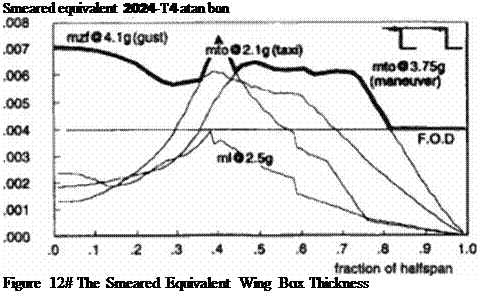Structural Loads and Weights
It is not just the aerodynamics that give the oblique flying wing an advantage over more conventional aircraft.
The location of aircraft components and the selection of the flight path and sweep can be done in such a fashion that the benefits of span loading can be achieved. Specifically, the following considerations have to be taken into account:
• Span loading All mass and load items arc distributed in such a way over the span that the structural bending loads are minimized. The embedded fuselage shells provide additional bending stiffness in the middle of the configuration Figure 128 shows the smeared equivalent skin box thickness distribution over the half span of the oblique flying w ing. Thus, span loading allows for an almost constant required skin thickness of 7mm allowing for efficient manufacturing
• Runway loads. The loads experienced during taxi and landing can be reduced by a two-legged main landing gear supported by a two auxiliary aft gears Such a layout also provides stable maneuvering during taxi. To allow the oblique flying wings to grow to the span required for efficient supersonic flight (120m) the gear legs have to be at least 40 to 50 meters apart. In order not to exceed the runway width such a gear span can only be achieved by sweeping
the wing to 45°.
• Gust loads. To reduce the gusts loads during climb the operation of the aircraft is restricted to lower equivalent airspeed than typical transonic transports. In addition the wing will have
to be swept to 50" to reduce the high lift gradients that cause high gust loads and to improve ride quality further.
Operation of the oblique flying wing in this fashion will increase the runway length and increase drag but not to the extent that this outweighs the structural advantages created by them. The advantages created by load minimization and span loading account for at least half the total economic benefits that are cited.
 |
from the application of composites materials then current subsonic aircraf t because of the higher productivity per pound of structural weight for a supersonic aircraft. However, in the case of the OFW their use is not required. Industry experience shows that intermediate carbonfibcrs with В MI resins achieve strain levels in excess of 0.5 % can result weight savings over conventional primary structures in excess of 25 $. The airframe life was specified to be over 75.000 hours with 50,000 supersonic flying hours and 25,000 pressure cycles A minimum skin thickness of 2 mm was specified to minimize foreign object damage.











